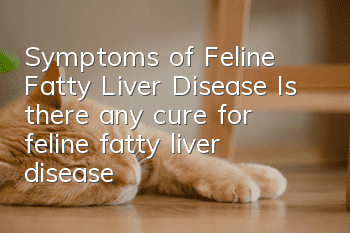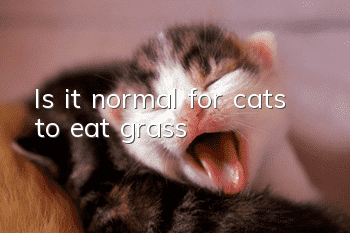Symptoms of Feline Fatty Liver Disease Is there any cure for feline fatty liver disease?

Feline fatty liver (feline hepatic lipidosis syndrome), as the name suggests, is the accumulation of excess fat in the cat’s liver, causing disease; although cats suffering from fatty liver in the early stages are in good spirits, they have no appetite. Cats in the middle and late stages will have symptoms such as drooling and frequent vomiting; if the cat has fatty liver, it should be sent to a pet hospital for treatment as soon as possible.
What is feline fatty liver
Feline fatty liver (feline hepatic lipidosis syndrome), as the name suggests, is the accumulation of excess fat in the liver of cats, causing disease. Cats have insufficient energy due to not eating for a long time, so they mobilize the body's fat reserves and convert them into energy. The main place for this work is the liver. If this process gets out of hand, feline fatty liver (hepatic lipidosis, referred to as HL) is formed. .
Feline fatty liver is more common in obese cats. It is the most common problem in cat liver diseases and one of the common clinical diseases. Feline fatty liver usually begins to appear after a cat has been on a hunger strike for 5 days, and jaundice begins to appear after a week of hunger strike. The direct cause of fatty liver disease in cats is anorexia, and there are many causes of anorexia, including various diseases and stress. In recent years, with the use of nasogastric feeding tubes, gastric feeding tubes, and esophageal feeding tubes, the cure rate of fatty liver disease in cats has been greatly improved.
Symptoms of fatty liver disease in cats
Early-stage fatty liver has no symptoms. The cat still looks energetic, but his appetite is not good. Sometimes, you will find that the cat no longer licks its fur, the amount of eye feces begins to increase, the third eyelid gradually appears, and some may drool, vomit frequently, etc. These are all signs that the cat is unwell.
When the disease progresses further, the cat still has poor appetite, begins to lose weight, has fewer or no defecation times (possibly constipation), and even the urine becomes severely yellow. At this time, some attentive parents will start to recall, did they do something recently that irritated the cat? Has the cat experienced or is experiencing something psychologically stressful? These are often the reasons why cats don’t eat or drink.
As time goes on, the cat begins to develop jaundice. Open the cat's mouth. The usually pink gums may start to turn yellow at this time, which is very critical. If it continues to worsen, the cat's blood coagulation ability will have problems, and bruises will appear if it stumbles. Cats with severe liver disease can also develop skin fragility syndrome and are prone to skin scarring.
Can cats with fatty liver be saved?
Knock on the blackboard: Parents need to remember that if a cat has fatty liver, it must be sent to the doctor immediately. It is difficult to treat fatty liver at home if you do not cooperate.Professional treatment is fatal in most cases. The cure rate of cat fatty liver has a great relationship with the timing of treatment and daily feeding amount. The earlier it is treated, the higher the cure rate and the lower the cost. Another factor is the amount of feeding. Cats with fatty liver disease should not be fed a large amount of food at the beginning of treatment. The maximum amount cannot exceed 25% of the energy requirement. If this standard is exceeded, refeeding syndrome will easily occur, and biochemical tests will show obvious signs. Hypophosphatemia, the symptom is hematuria (because it is often believed that feeding a large amount of food will improve the therapeutic effect, so even some novice doctors will have such problems, the feeding amount needs to be calculated accurately), and timely monitoring and fluid replenishment are required .
Complications of Feline Fatty Liver
In addition, parents need to pay attention to the fact that the symptoms of feline fatty liver are related to feline hepatic encephalopathy, feline abdominal transmission, feline granulocytic cholangiohepatitis, feline lymphocytic cholangiohepatitis, feline obstructive cholangiohepatitis, feline The symptoms of blood parasitic diseases are very similar and need to be distinguished. Hospitals or doctors with insufficient experience may miss diagnosis or misdiagnose, so when cats develop jaundice, they should go to a large hospital for diagnostic examination as much as possible to prevent iatrogenic factors from aggravating the condition and avoid tragedy.
To treat and prevent fatty liver disease in cats, keep the eight-character motto in mind: ensure diet and reduce stress.
- What are the benefits to cats of eating acidified food?
- Can cats drink light salt water if they have heatstroke?
- Why did a Ragdoll cat have diarrhea after eating canned food? What caused it?
- Why cats like to drink milk
- Will British shorthair cats become dependent on probiotics if they often eat them? A must-read for pet owners!
- How to treat nasal branch in Balinese cats
- What should a novice prepare for raising a cat for the first time?
- Misunderstandings about deworming | How to correctly deworm parasites on cats?
- What to do if there is poop on the cat’s anus
- Why do Cornish Rex cats need to be neutered?



